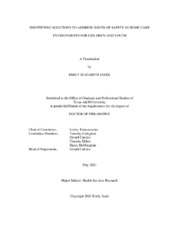| dc.description.abstract | Many children and youth with special health care needs (CYSHCN) rely on home care and home health to have integrated and healthy lives in the community. For home care to be effective, it must also be safe. The purpose of this qualitative research study with a multiple case study approach was to explore what caregivers of CYSHCN perceive to be the safety issues in the home care environment and how they solve these issues.
I utilized convenience sampling to recruit fourteen formal, informal, and dual-role caregivers into the study. Caregivers participated in semi-structured interviews that discussed their safety concerns, how they addressed them, and what challenges remain. Multiple strategies (including member checking, peer debriefing, and creating an audit trail, among others) were incorporated throughout the study processes to maximize the credibility, dependability, confirmability, and transferability of the study. I used constant comparative analysis to generate findings.
The findings indicate that caregivers have many physical, mental/emotional, interpersonal, and spatial safety concerns in the home care environment. The most frequently cited safety concerns were injuries to the child/youth and the interactions between formal caregiver, informal caregiver, and the child/youth. To address these concerns, caregivers use training, preemptive activities (like cleaning and exercise), and several tools (devices, medical equipment, emergency bags, home modifications). Caregivers recognized that becoming familiar with the environment and other caregivers was paramount to feeling safe and described various processes to do so. The use of solutions varies by type of caregiver, with formal caregivers more frequently using organizational supports. In contrast, informal caregivers turn to the internet or other parents to figure out what solutions work for them. Still, challenges remain in addressing safety, including training and devices that do not work for the caregivers or the home, costs of implementing solutions, and navigating formal services.
This study provides recommendations on defining and addressing safety based on the issues described by those with lived experience. Future safety interventions need to be comprehensive, realistic, and tailored to the child/youth to be effective and sustainable. | en |


